When I reflect on my 27-year teaching career, I am both in disbelief and in awe at how far we have come. My go-to tools in 1997 included 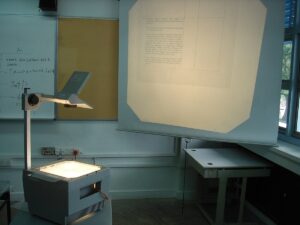 overhead projectors, chalkboards, filmstrips, and VHS players. Students relied on encyclopedias for research and used the Dewey Decimal System to navigate the school library.
overhead projectors, chalkboards, filmstrips, and VHS players. Students relied on encyclopedias for research and used the Dewey Decimal System to navigate the school library. Learning was largely one-size-fits-all, and access to information was limited to what was physically available in the classroom or library. My students took out their pens or pencils and looseleaf and took notes as I taught. My role as an educator (or so I thought!) was to get through the curriculum, deposit as much information I could into the empty vessels that sat in the desks in my classroom and then assess them, based on how much information could recite or regurgitate.
Learning was largely one-size-fits-all, and access to information was limited to what was physically available in the classroom or library. My students took out their pens or pencils and looseleaf and took notes as I taught. My role as an educator (or so I thought!) was to get through the curriculum, deposit as much information I could into the empty vessels that sat in the desks in my classroom and then assess them, based on how much information could recite or regurgitate.
The rapid evolution of technology in education has pushed me to grow, adapt, and reimagine my approach to teaching and learning. That is not to say it has been easy. There have been many moments of feeling overwhelmed, and frustrated by the constant wave of new tools, platforms, and shifting expectations. I often found myself questioning why we needed so much technology in the classroom. At times, the pressure to continuously “entertain” students with engaging, tech-enhanced lessons felt exhausting and unsustainable (and sometimes still feels this way!!)
But over time, I have (slowly) come to realize that technology is not the enemy. Teaching and technology can co-exist and although the educational tools have changed, 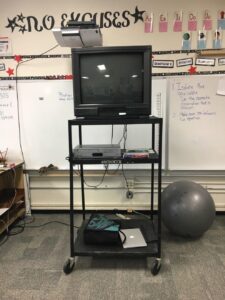 the heart of teaching remains the same. Technology did not just change what I was teaching- it transformed
the heart of teaching remains the same. Technology did not just change what I was teaching- it transformed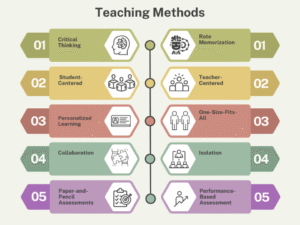 how I taught. I still remember the excitement of showing a documentary on a DVD player in my Social Studies class—it felt like cutting-edge technology at the time! Being able to show a documentary, allowed me to supplement my unit and and bring the content to life in a way that textbooks (or me!) could not. Little did I know back then, that I was integrating technology into the classroom.
how I taught. I still remember the excitement of showing a documentary on a DVD player in my Social Studies class—it felt like cutting-edge technology at the time! Being able to show a documentary, allowed me to supplement my unit and and bring the content to life in a way that textbooks (or me!) could not. Little did I know back then, that I was integrating technology into the classroom.
Through the discomfort of learning new technology, I was pushed to reflect on my role as an educator. Over time, I evolved from the traditional “sage on the stage” to more of a facilitator—supporting students as they explore, create, and collaborate in ways that simply weren’t possible back in 1997.
- Technology lowers academic performance
- Technology broadens the schism that is the digital divide
- Technology is detrimental to the overall well-being of students
- Technology serves as a conduit for distract in the learning process
- Technology usage comes at a high cost
Our classmates brought forward a variety of thoughtful perspectives on the use of technology in the classroom. Some emphasized that students don’t need to be constantly entertained, and that technology should be used with intention and balance. Jessalyn highlighted that boredom isn’t necessarily a bad thing—it can spark creativity and resilience. Danielle raised concerns about how easily technology can become a source of distraction, while Rose noted its potential to support diverse learning styles and make content more accessible for all students.
While Jenni and I agree that technology is not the be-all and end-all of great teaching, we believe it can enhance learning when:
1) Educators know how to integrate it effectively and intentionally. Unfortunately, there are still many misconceptions 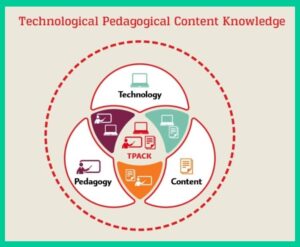 about what technology does in the classroom and how educators use it. It often gets a bad rap—dismissed as a distraction or seen as a shortcut. But when used with intention and purpose, technology can be one of the most powerful tools we have to enhance learning, meet diverse student needs, and make classrooms more engaging and inclusive than ever before. While researching for the debate, I was intrigued about learning about the TPACK model. TPACK—Technological Pedagogical Content Knowledge—helps educators move beyond simply using technology to integrating it effectively. It emphasizes the importance of balancing what we teach (content knowledge), how we teach it (pedagogy), and the tools we use to support that process (technology). When these three elements work together, technology becomes a meaningful extension of strong instructional practice, not a replacement for it.
about what technology does in the classroom and how educators use it. It often gets a bad rap—dismissed as a distraction or seen as a shortcut. But when used with intention and purpose, technology can be one of the most powerful tools we have to enhance learning, meet diverse student needs, and make classrooms more engaging and inclusive than ever before. While researching for the debate, I was intrigued about learning about the TPACK model. TPACK—Technological Pedagogical Content Knowledge—helps educators move beyond simply using technology to integrating it effectively. It emphasizes the importance of balancing what we teach (content knowledge), how we teach it (pedagogy), and the tools we use to support that process (technology). When these three elements work together, technology becomes a meaningful extension of strong instructional practice, not a replacement for it.
2) Educators know the types of learners they have in their classrooms. While the TPACK model offers a valuable framework for integrating technology with content and pedagogy, it is also important to consider the evolving needs and characteristics of today’s learners. Marc Prensky and Ian Jukes 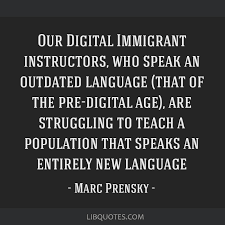 both emphasize the transformative power of technology in education, arguing that it enhances learning by aligning with how today’s students think and process information. Prensky
both emphasize the transformative power of technology in education, arguing that it enhances learning by aligning with how today’s students think and process information. Prensky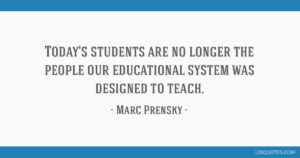 highlights the need to engage “digital natives” through interactive, student-centered approaches like game-based and real-world learning. Jukes focuses on the neurological shifts in the “digital brain,” urging educators to redesign instruction for a rapidly changing, tech-driven world. Together, they call for a fundamental shift in teaching—one that embraces technology to make learning more relevant, personalized, and future-focused. Both Prensky and Jukes argue that technology isn’t just an add-on—it’s essential for engaging today’s learners, making learning relevant, and preparing students for a complex, fast-changing world.
highlights the need to engage “digital natives” through interactive, student-centered approaches like game-based and real-world learning. Jukes focuses on the neurological shifts in the “digital brain,” urging educators to redesign instruction for a rapidly changing, tech-driven world. Together, they call for a fundamental shift in teaching—one that embraces technology to make learning more relevant, personalized, and future-focused. Both Prensky and Jukes argue that technology isn’t just an add-on—it’s essential for engaging today’s learners, making learning relevant, and preparing students for a complex, fast-changing world.
3) Educators know how to manage a digital classroom. Trying to navigate, manage and monitor a digital classroom can be very challenging for 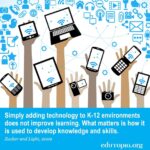 teachers. A digital classroom requires purposeful planning and organization. Educators must clearly define how technology supports learning goals, organize spaces for collaboration, and establish expectations for responsible use. A strong management plan also includes contingency strategies for tech issues and guidelines for organizing and sharing digital work.
teachers. A digital classroom requires purposeful planning and organization. Educators must clearly define how technology supports learning goals, organize spaces for collaboration, and establish expectations for responsible use. A strong management plan also includes contingency strategies for tech issues and guidelines for organizing and sharing digital work.
Technology should enhance—not replace—great teaching. When used with purpose, it can deepen learning, increase engagement and help students connect with the real world. Even with all the technology, 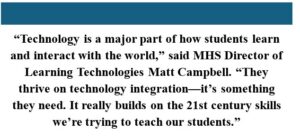 it is the teacher who makes the learning meaningful—by inspiring curiosity, building connections, and supporting each student’s journey. When it is used the right way, technology gives both teachers and students the tools they need to keep up, grow, and thrive in today’s digital world.
it is the teacher who makes the learning meaningful—by inspiring curiosity, building connections, and supporting each student’s journey. When it is used the right way, technology gives both teachers and students the tools they need to keep up, grow, and thrive in today’s digital world.
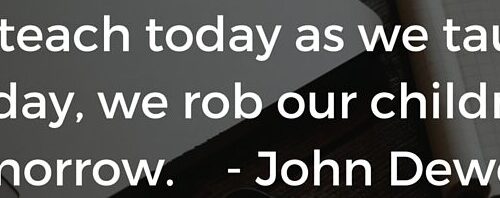
2 Comments
Teagan Schiltz
Hey Leanne.
It’s lovely to see you in another Masters class! I love your energy and passion – both in class and in writing – and always appreciate hearing your thoughts based on an incredible education career – 27 years of experience? That’s incredible.
I enjoyed reading your post and also engaging in your debate! I, too, feel passionately that technology does enhance learning…when integrated meaningfully. In the debate, you spoke about intentional tech use, and that has really resonated with me as I read, reflected and wrote my blog and responses this week. I think everything done with technology needs to be intentional, otherwise tech loses its value to us, especially in education. I have heard of other tech usage models that help guide educations in purpose, like SAMR, but not TPACK – I will have to read more into that!
I also appreciated your rebuttal, in the debate, about appropriate technology use in the classroom based on a strong foundation of practiced procedures. Students need support with anything new in the classroom, so clear guidance on tech usage should be no different. I really see the importance of strong routines and procedures with my primary kiddos as I, increasingly each year it seems, try to incorporate more intentional tech use in the classroom.
You and Jenni did a wonderful job arguing your side, and I thought Dustin did great too. I imagine it was challenging to argue against tech use in an educational technology class, but he also made some points against tech usage that had me second guessing my pro-tech vote. Overall, I remain pro-tech…or pro-‘intentional’ tech as you inspired me to think of it as. Thanks for the thought-provoking debate and reflective blog post!
Teagan
Sadi-Ann Richards-Palmer
Hi Leanne
Thanks for this authentic and inspiring reflection. As a person from the encyclopedia and library days, I am often playing catch-up in this fast-paced digital age. Your journey truly resonates with me. I especially appreciate your reminder that technology, when used intentionally can deepen learning without replacing the core of great teaching. Your insights into the TPACK model and the evolving role the teacher as facilitator rather than information dispenser; gave me both perspective and hope. It is encouraging to know that feeling overwhelmed (as I sometimes do) is a natural part of the process and that growth is possible with patience, purpose and reflection. As we continue on this learning path, it is both intriguing and scary; still, we press on.